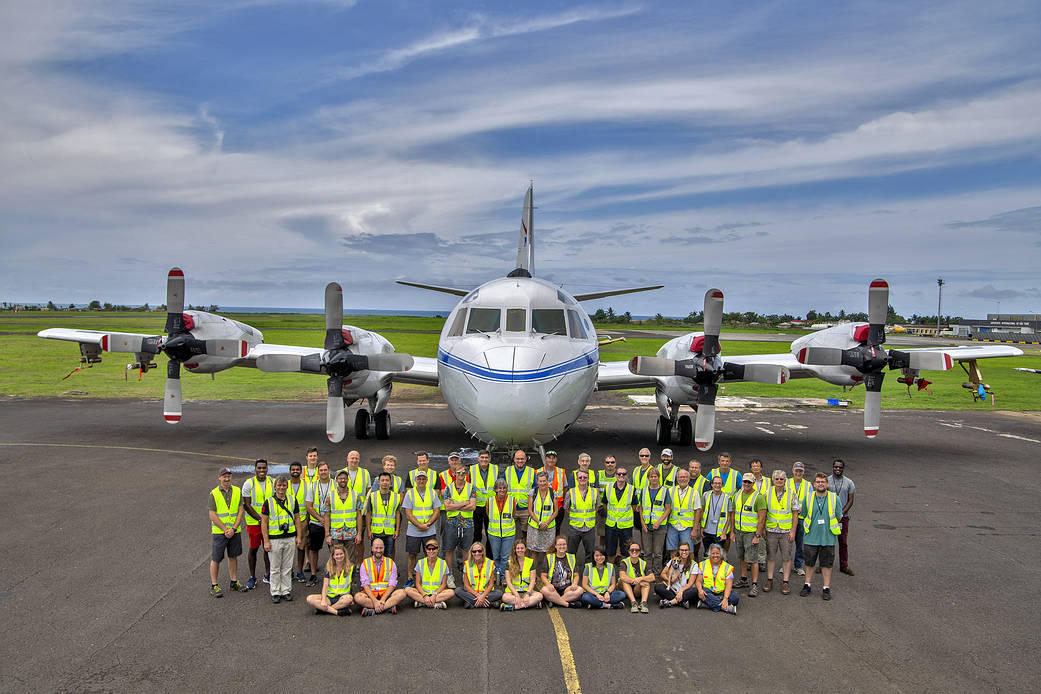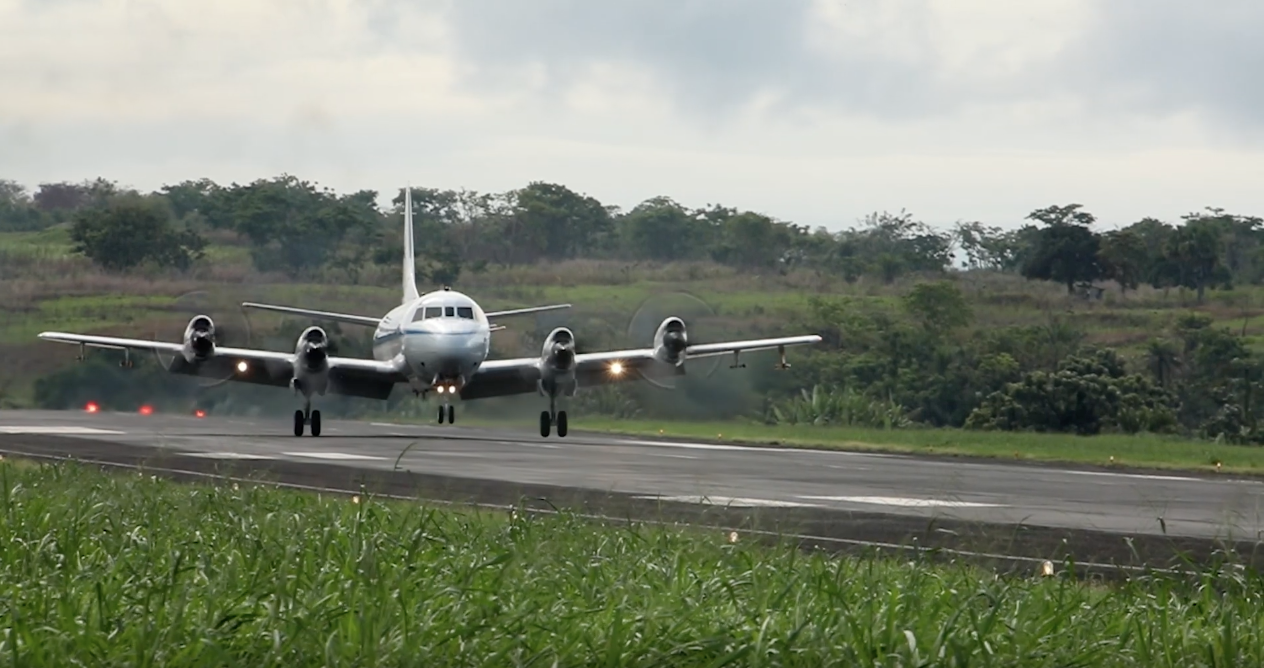Like clock-work, the burning season over Southern Africa begins late winter until early spring each year. African farmers till, then burn, their fields after harvesting the last of their crops before the rainy season, as the smoke coils westward across the coast. The haze creates a visible plume 2,000 miles in length, observable from satellite images in space. The smoke, a combination of black carbon (soot) with organic aerosols, drifts into the atmosphere, creating a soup that mixes with a near-permanent off-shore cloud deck – long, wavy clusters of stratocumulus clouds.
“The cloud deck in the southeast Atlantic is one of the largest on the globe,” said atmospheric scientist Dr. Paquita Zuidema of the University of Miami, Florida, and co-principal investigator for ORACLES. “At the same time, the smoke layer stretches all the way to South America. The combination of smoke and clouds generates enough atmospheric warming to affect precipitation patterns over Africa in climate models, making it imperative to develop better confidence in the model predictions.”
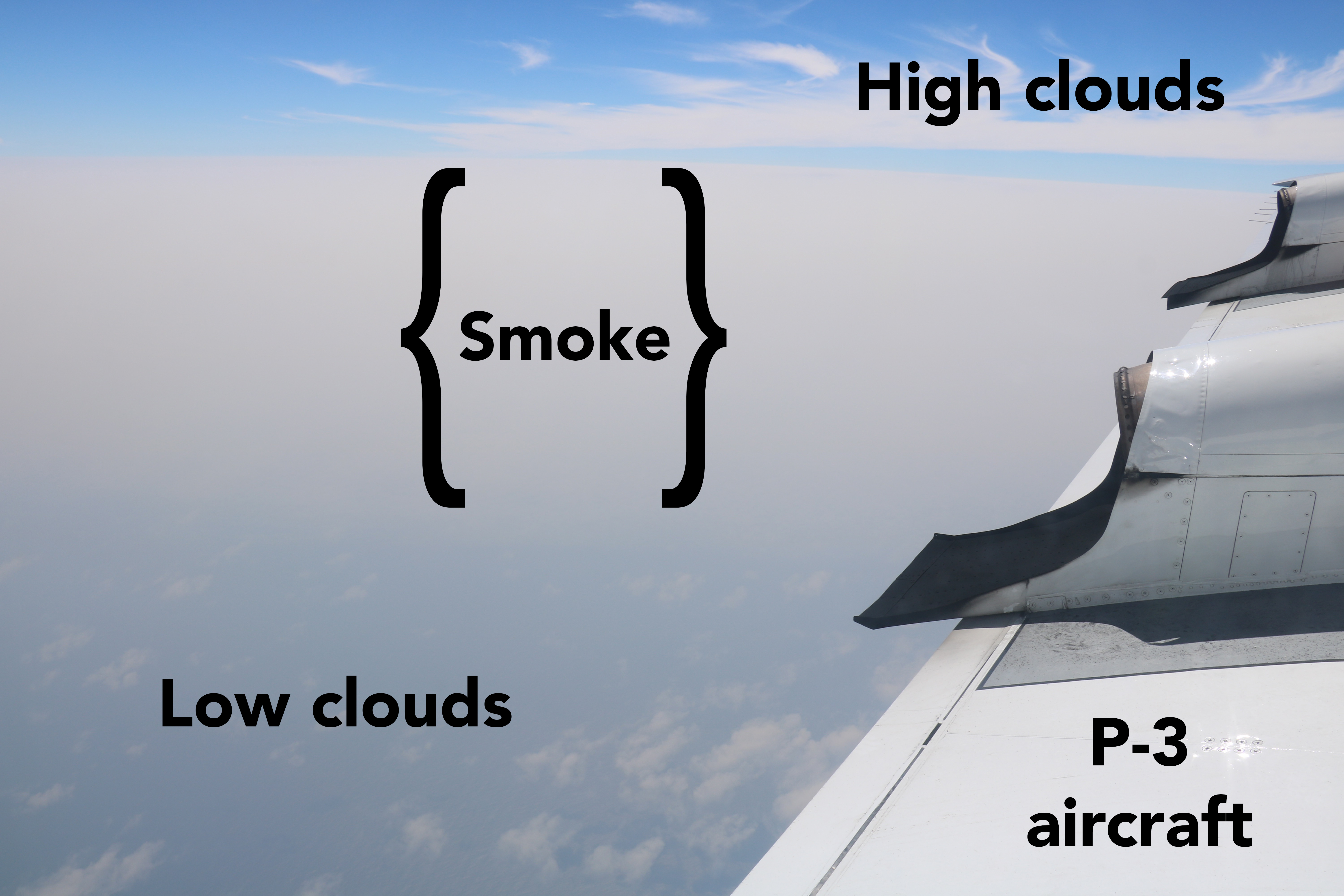
It was in this unique environmental region – with the smoke particles overlaying the cloud deck, like a sandwich – that ORACLES (Observations of Aerosols Above Clouds and their interactions) conducted its three-year survey mission. Depending on how the smoke and cloud deck interact, the clouds may thicken, burn-off, and/or change their drop sizes, which also affects their ability to produce rain. Directly measuring these observations are like putting a microscope on what’s happening inside the clouds.
“It started as a way to try and quantify the effect of aerosols on the climate. But it became clear, after looking at the models, that there are big discrepancies on how both the aerosols and clouds are represented in the models, which affects their ability to model the regional climate,” explained Dr. Zuidema. “We knew based on the large scale of discrepancies, and lacking any recent in situ instrumental measurements, that we needed to conduct further studies.”
Beginning at the southern extent of the plume from Walvis Bay, Namibia, in September of 2016, ORACLES used a NASA ER-2 to map the region from high-altitude, combined with low-altitude P-3 in-situ measurements of aerosols and clouds. In subsequent years, the team captured data on the dense aerosol-cloud mixture, from the northern part of the smoke plume, by basing in São Tomé within the equatorial Gulf of Guinea. Unlike the smaller ER-2, the P-3 research aircraft carries a suite of 11 instruments that include remote sensing instruments, as well as instruments that directly sample the clouds and smoke plume through air inlets on the fuselage and windows. These measurements include the highly sensitive 4STAR (Spectrometer for Sky-Scanning, Sun-Tracking Atmospheric Research) for discriminating the portion of the aerosol loading above the cloud deck.
“Reliable, high-quality instruments are needed in order to fully characterize properties of the smoke and clouds that we cannot yet measure from satellites,” states Dr. Robert Wood of the University of Washington, and ORACLES Co-Principal Investigator. “We only get a limited number of flights during each campaign, and so ensuring that instruments are fully working on each flight is critical. In addition to spending time taking the measurements, instrument teams work hard to make sure their instruments are well-calibrated, cleaned, and fully-functional.”
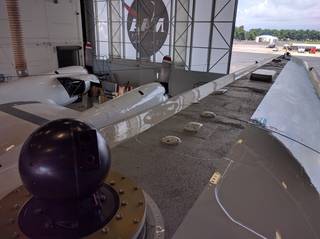
Climate change and action of atmospheric proportions
Aerosols play a key part in Earth’s climate. Dark-colored aerosols absorb sunlight, causing a warming effect. On the other hand, light-colored aerosols reflect sunlight, causing a cooling effect. For years it has been known that smoke lessens the clouds’ cooling effect when it is located above the cloud deck, by absorbing the light that clouds beneath the aerosols would otherwise reflect back to space. Smoke particles, however, can absorb and reflect sunlight, depending on whether the particles within it occur over the dark ocean and look whiter in comparison, or above clouds and look darker. When the smoke aerosols mix with the clouds, they can reduce the cloud droplet size, and for the same liquid water path, the cloud will end up ‘reflecting” more solar radiation to space causing a cooling effect below. When these interactions occur over the entire southeast Atlantic, substantial cooling and warming of the Earth is possible, likely varying with each month.
Although it became clear about 40 years ago that aerosols could affect climate, the measurements needed to establish the magnitude of such effects—or even whether specific aerosol types warm or cool the surface—were lacking.
“This survey needed to be in three different years for logistical reasons, conducting science during three different fire months — namely August, September and October,” explained Dr. Leonhard Pfister, research atmospheric scientist at NASA Ames, who was the meteorologist for ORACLES. “Why? Well, we expected a seasonal evolution for the biomass burning, the convection (rainfall), and the circulation. And sure enough, that is what we eventually found. Portions of the fires starting out over the African coastline moved south. Most of the smoke then come from around the equator. The rains also moved to the south from August to October. The altitudes, transport speeds, and vertical mixing mechanisms changed from month to month.”
At the latest 2018 AGU Fall conference, 21 research posters and discussions revealed current conclusions and possible applications for enhancing future climate models, with more results yet to come as the team continues to verifies data measurements. These lessons learned might be applied to other areas where smoke from wildfires or industry interacts with clouds, such as the annual fire season in California. Smoke and other aerosols represent the largest uncertainty in our calculations of the changes in the earth’s radiation budget. The understanding of smoke and clouds derived from ORACLES will be part of reducing that uncertainty.
Navigating science and politics
Organizing a three-year science mission in the Southern Hemisphere came with its own set of logistical challenges. To start, initial operations were to be based in Walvis Bay, Namibia.
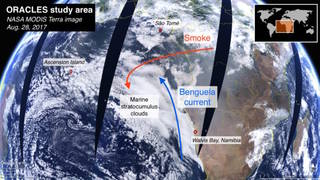
“Logistically, it posed a big challenge,” explained Zuidema. “During the first year we worked out an agreement with Namibia that allowed us to base both the ER-2 and P-3 planes in Namibia. This was particularly helpful for the ER-2, which is a specialized airplane that requires additional fuel, runway and hangarage needs that are unavailable at many airports. Unfortunately things did not work out in the long-term, despite our best efforts, such as hosting research outreach within the community, and inviting local Namibian student scientists to shadow us.”
In the end, another venue needed to be found within the same region after the first year. So in 2017, the ORACLES team switched to be based out of São Tomé and Principé, an equatorial island nation off the west coast of Africa. The São Tomé airport and meteorological community were welcoming to the NASA team, but it posed a unique environment to operate.
“Probably the single biggest adjustment for us was the difference in available infrastructure in São Tomé,” explained Dr. Bernadette Luna, Deputy Director at the NASA Ames Earth Science Project Office. “It’s a good thing we brought a generator; power outages were common at the airport in 2018. The team shipped a significant quantity of aircraft parts and scientific spares as ‘quick shipments’ are very difficult to this location. We had a plan for ending deployment at one of two dates, depending on expenses incurred and progress toward science goals, and that required extensive coordination.”
“Year two almost turned into year one. We had to start over,” added Zuidema. “However, we found that over the next two years it was a wonderful experience. As an added benefit, we now have a more robust data set with the opportunity to observe the North and South sides of the southern African biomass burning plume. In the end, this complimented the science greatly and we got two different views of a fairly complex system. Logistically, switching was a ton of work — but it worked out!”
Final thoughts and moving into the future
Flying through smoke and clouds, this “petri-dish” was an ideal sky lab for understanding the dynamics through which the smoke particles interact with clouds, altering the reflection/absorption of radiation over the South Atlantic. It was through this process of high altitude and in-situ airborne field work combined with ground-based observations that the team built an extremely robust science data set over the South East Atlantic. It is hoped this science will contribute to furthering Earth Science and enhancing climate models.
“We are seeing more aerosol than expected based on aerosol model forecasts and previous satellite assessments for this month,” said Zuidema. “Scientifically, we are seeing unexpected new features such as very large smoke particles that seem to be falling out of their smoke layers into the clouds below. We’re seeing clouds that transform from clean to polluted over large areas in only two days.”
The measurements taken during the ORACLES investigation are proving to be invaluable for testing and improving our models of aerosols, clouds and their interactions.
“Climate models produce a wide range of estimates of how smoke is impacting the Earth’s energy budget, and new constraints on how much sunlight is absorbed by the smoke particles should allow us to narrow the range of plausible estimates of the climate effects of southern African biomass burning,” said Wood. “The observations are already telling us that smoke in models tends to sink down into the clouds too quickly as it moves over the southern Atlantic.”
“We are also finding evidence that smoke can both influence precipitation falling from the low clouds over the region, but this precipitation may also serve as an effective cleansing mechanism for smoke removal,” he added. “Another surprising finding from ORACLES is that the measurements suggest previously uncharacterized chemical aging processes taking place within the smoke plume that can cause the removal of some of the material within the aerosol particles, with potentially major consequences for the lifetime and therefore climate impacts of smoke particles in the atmosphere.”
Learn more:
The airborne missions are over, but the science lives on for ORACLES. The next data workshop will be held April 2-4 in Paris, in collaboration with several other recent international projects focusing upon smoke-climate interactions over the southern Atlantic. Promoting collaboration opportunities with international partners is essential for generating a comprehensive, yet detailed understanding of the processes that control the impacts of biomass burning smoke on the regional and global climate system.
Author: Kassie Perlongo



























